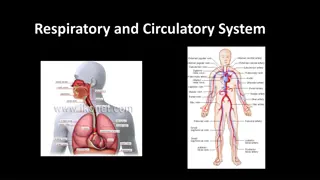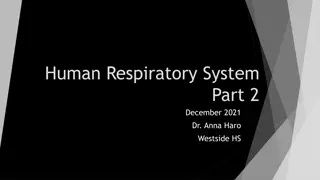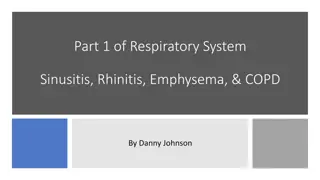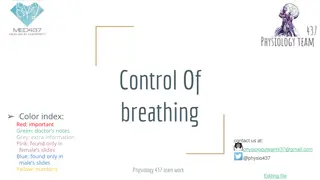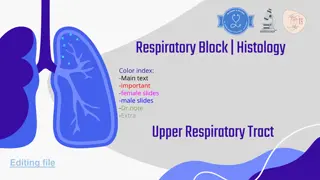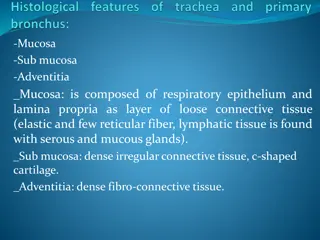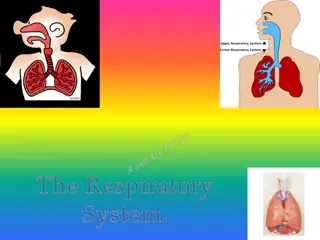Understanding the Respiratory System and Its Functions
Within the complex respiratory system, the goal is to provide oxygen to tissues and remove CO2. It consists of airways, muscles, and centers. Functions include gas exchange, phonation, and pulmonary defense. The system also performs non-respiratory functions like converting Angiotensin I to II, regulating acid-base status, and secretion of surfactant. An in-depth look at the structures, functions, and organization of the system is provided. Key learning objectives encompass understanding the zones of airways, respiration types, and the system's broader functions beyond respiration.
Download Presentation

Please find below an Image/Link to download the presentation.
The content on the website is provided AS IS for your information and personal use only. It may not be sold, licensed, or shared on other websites without obtaining consent from the author. Download presentation by click this link. If you encounter any issues during the download, it is possible that the publisher has removed the file from their server.
E N D
Presentation Transcript
Respiratory Physiology Dr. Aida Korish Associate Prof.Physiology KSU Dr.Aida Korish ( akorish@ksu.edu.sa)
The main goal of respiration is to 1 Provide oxygen to tissues 2 Remove CO2 Respiratory system consists of: passages (airways) muscles centers Dr.Aida Korish ( akorish@ksu.edu.sa)
Functions and organization of the respiratory system Dr.Aida Korish ( akorish@ksu.edu.sa)
Learning Objectives By the end of this lecture you will be ableto:- 1-Describe the structures and functions of the conductive and respiratory zones of airways. 2- Understand the difference between internal and externalrespiration. 3- Understand the functions of the respiratory system, including non- respiratory functions, like clearance mechanism by mucus and cilia, production of surfactant and its physiologicalsignificance. Dr.Aida Korish ( akorish@ksu.edu.sa)
Functions of the respiratory system include Gas exchange (respiratory function). Phonation: is the production of sounds by the movement of air through the vocal cords. Pulmonary defense - Immunoglobulin A(IgA), - Alpha-1 antitrypsin - The pulmonary macrophagesin the alveoli: engulf smaller particles which pass through themuco- cilliary barrier filter. Dr.Aida Korish ( akorish@ksu.edu.sa)
Cont..non respiratory functions of lung Angiotensin I is converted to angiotensin II with the help ofangiotensin converting enzyme formed by the lungs. Regulating the acid- base status of the body by washing out extra carbon dioxide from the blood. Secretion of important substances like surfactant . Dr.Aida Korish ( akorish@ksu.edu.sa)
Respiratory passages ( airways) Dr.Aida Korish ( akorish@ksu.edu.sa)
Respiratory passages airways can be divided into Dr.Aida Korish ( akorish@ksu.edu.sa)
II- Respiratory Zone (Respiratory unit) I- Conductive Zone Starts from nose to the end of terminalbronchioles. Help warming, humidification, filtration of inspiredair. Contains the Includes: Respiratory bronchioles, alveolar ducts, alveolar sacs, alveoli Function in gasexchange. olfactory receptors for smellsensation. Conducts the sound during speech. P r otective function by cough and sneezingreflexes. Dr.Aida Korish ( akorish@ksu.edu.sa)
Internal & External Respiration Dr.Aida Korish ( akorish@ksu.edu.sa)
Externalrespiration 3 major functional events occurs during it: 1- Pulmonary ventilation: inward and outward movement of air between lung and atmosphere. 2- Diffusion of oxygen and CO2 between the alveoli and the pulmonary capillary blood 3- Transport of O2 & Co2 in the blood and body fluids to and from thecells Respiration could be either Resting: normal breathing during resting conditions. Forced (maximal): during exercise, in patients with asthma, allergy, Dr.Aida Korish ( akorish@ksu.edu.sa)
Lining cells of thealveoli 1- Type I alveolar cells ( type I pneumocytes) 2- Type II alveolar cells ( type II pneumocytes) (Secretesurfactant) 3- Alveolar macrophages Dr.Aida Korish ( akorish@ksu.edu.sa)
Surface Tension H2O molecules at the surface are attracted to other H2O molecules by attractive forces that resist distension called surface tension. Surface tension tends to oppose alveoli expansion. Pulmonary surfactant reduces surface tension. Dr.Aida Korish ( akorish@ksu.edu.sa)
Surfactant Surfactant is a complex substance containing phospholipids and a number of apoproteins. Secreted by the Type II alveolar cells. The earliest detection from fetal alveoli begins between 6- 7th month but this could be delayed in others towk 35 of intrauterine life. Surfactant reduces surface tension throughout the lung, prevents alveolar collapse, decreases airway resistance and the work ofbreathing. Dr.Aida Korish ( akorish@ksu.edu.sa)
Contsurfactant Deficiency in premature babies cause respiratory distress syndrome of the new born (RDS) ( hyaline membrane disease) Smoking in adult, hypoxia or hypoxemia (low oxygen in the arterial blood) or both, decrease the secretion of surfactant and cause adult respiratory distress syndrome. Dr.Aida Korish ( akorish@ksu.edu.sa)
Innervations of lungs and bronchi Is by autonomicnerves. Sympathetic stimulationcauses dilatationof the bronchi Parasympathetic stimulation causes constriction of the bronchi. Locally secreted factors :histamine, slow reacting substances of anaphylaxis (SRSA) by mast cells, due to allergy ( as in patients with asthma) often cause bronchiolar constriction and resistance. increase airway Dr.Aida Korish ( akorish@ksu.edu.sa)
Mechanics of pulmonary ventilation Dr.Aida Korish ( akorish@ksu.edu.sa)
Learning Objectives By the end of this lecture you will be able to: 1 List the muscles of respiration and describe their roles during inspiration and expiration. 2 Understand the importance of the following pressures in respiration: atmospheric, transpulmonary. 3 Explain why intrapleural pressure is always subatmospheric under normal conditions, and the significance of the thin layer of the intrapleural fluid surrounding the lung. 4 Define lung compliance and list the determinants of compliance. alveolar, intrapleural, and Dr.Aida Korish ( akorish@ksu.edu.sa)
Respiratorymuscles Inspiratorymuscles (resting- forced) Expiratory muscles (forced expiration- muscles that depress the ribcage) Dr.Aida Korish ( akorish@ksu.edu.sa)
Deep Forceful Breathing Deep Inspiration During deep forceful inhalation accessory muscles of inspiration participate to increase size of the thoracic cavity Sternocleidomastoid elevate sternum Scalene elevate first two ribs Pectoralis minor elevate 3rd 5thribs Deep Expiration Expiration during forceful breathing is active process. Muscles of exhalation increase pressure in abdomen and thorax Abdominal muscles. Internal intercostals. Dr.Aida Korish ( akorish@ksu.edu.sa)
Air will flow from a region of high pressure to one of low pressure-- the bigger the difference, the faster the flow Dr.Aida Korish ( akorish@ksu.edu.sa)
Pressure changes in the lungs during breathing 1-Intra-alveolar (intrapulmonary pressure Between breathes =zero pressure During inspiration = (-1 mmHg). air (tidal volume) flow from outside to inside the lungs). At the end of inspiration =zero. air flow stops. During expiration = (+1 mmHg). air flow out of the Lungs Dr.Aida Korish ( akorish@ksu.edu.sa)
2-Intrapleural pressure (IPP): Pressure in the pleural space is negative with respect to atmospheric pressure at the end of normal expiration( -5cmH2O). Why negative??: 1The lung's elastic tissue causes it to recoil, while that of the chest wall causes it to expand. Because of these 2 opposing forces the pressure in the pleural cavity becomes negative. 2The pleural space is a potential space, empty due to continuous suction of fluids by lymphatic vessels. Dr.Aida Korish ( akorish@ksu.edu.sa)
Values ofIPP (-5) cm H2O during resting position between breathes, and it becomes more ve (-7.5) cm H2O during resting inspiration. Forced ventilation Insp. :-20 to - 40 cm H2O Exp. : + 30 cm H2O Dr.Aida Korish ( akorish@ksu.edu.sa)
3-Transpulmonary pressure (TPp) (Extending Pressure) The difference between the alveolar pressure (Palv) and the pleural pressure(Ppl). TPp = Palv-Ppl It is a measure of the elastic forces in the lungs that tend to collapse the lungs (the recoil pressure). It preventslung collapse. The bigger the volume of the lung the higher will be its tendency to recoil. Dr.Aida Korish ( akorish@ksu.edu.sa)
(Compliance ofthe lung) in a single respiratory cycle Dr.Aida Korish ( akorish@ksu.edu.sa)
Is defined as, the ratio of the change in the lung volume produced per unit change in the distending pressure. The extent to which the lungs expand for each unit increase in the transpulmonary pressure. CL= Volume change ( V) Transpulmonary pressure change ( P) CL = ( V) ( P) Dr.Aida Korish ( akorish@ksu.edu.sa)
Contcompliance of lung For both lungs in adult = 200 ml of air /cm H20. For lungs and thorax together = 110 ml/cm H20. Is reduced in pulmonary fibrosis , pulmonary edema, diseases of the chest wall ( kyphosis, scoliosis) Emphysema increases the compliance of the lungs because it destroys the alveolar septal tissue rich with elasticfibers that normally opposes lung expansion. Dr.Aida Korish ( akorish@ksu.edu.sa)








